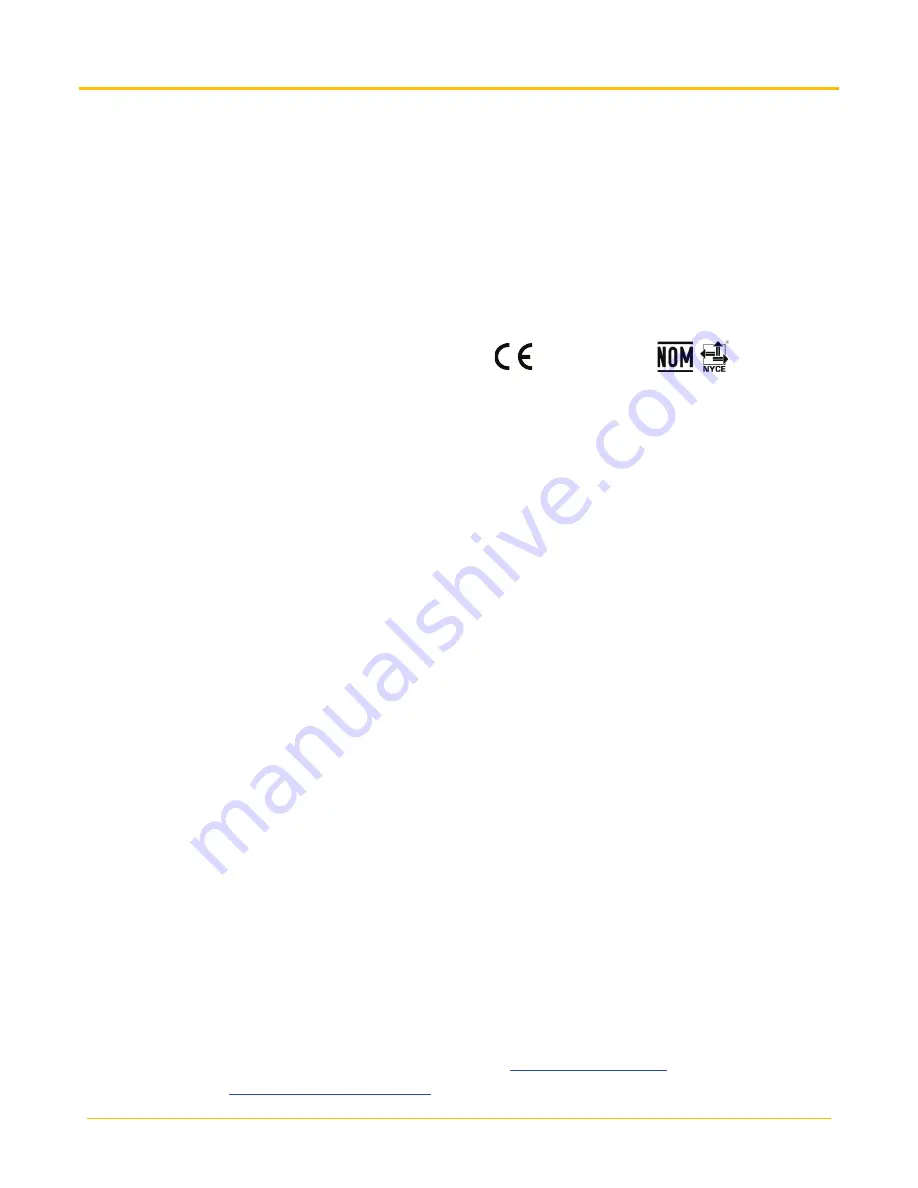
Banner Engineering Corp.
Vibration Monitoring Solutions Kit Quick Start Guide
Page 13
214301 Rev. C
Specifications
Supply Voltage
24 V DC (±10%) (use only with a Class 2 (UL) power supply or a Limited
Power Source (LPS) (CE) power supply)
Power Consumption
9 W average; 30 W maximum
Operating Conditions
0 °C to +50 °C (32 °F to +122 °F) (HMI);
–20 °C to +60 °C (–4 °F to +140 °F)
90% maximum relative humidity (non-condensing)
900 MHz Compliance (1 Watt)
FCC ID UE3RM1809: This device complies with FCC Part 15, Subpart
C, 15.247
IC: 7044A-RM1809
2.4 GHz Compliance
FCC ID UE300DX80-2400: This device complies with FCC Part 15,
Subpart C, 15.247 ETSI EN 300 328: V1.8.1 (2012-04)
IC: 7044A-DX8024
Radio Range
900 MHz, 1 Watt: Up to 9.6 km (6 miles)
2.4 GHz, 65 mW: Up to 3.2 km (2 miles)
Spread Spectrum Technology
FHSS (Frequency Hopping Spread Spectrum)
Antenna Minimum Separation Distance
900 MHz 150 mW/250 mW: 2 m (6 ft) 900 MHz, 1 Watt: 4.57 m (15 ft)
2.4 GHz 65 mW: 0.3 m (1 ft)
Radio Transmit Power
900 MHz, 1 Watt: 30 dBm (1 W) conducted (up to 36 dBm EIRP)
2.4 GHz, 65 mW: 18 dBm (65 mW) conducted, less than or equal to 20
dBm (100 mW) EIRP
Mounting
A mounting system with various mounting options is provided with this
enclosure. To connect the mounting brackets, turn the enclosure such
that the backside is visible. Place the mounting brackets over the
octagon bosses either horizontally, diagonally, or vertically, and fasten
them with the ¼”-20 x 0.25” SS, countersunk Philips drive screws
provided (torque limit = 30 in. lbs.). The enclosure can be mounted
vertically (on a wall) or horizontally (table top).
Certifications
(CE applies only to model
SolutionsKit2-Vibemetric-MH)
(NOM applies only to the 900
MHz models)
FCC Part 15 and CAN ICES-3 (B)/NMB-3(B)
This device complies with part 15 of the FCC Rules and CAN ICES-3 (B)/NMB-3(B). Operation is subject to the following two conditions:
1.
This device may not cause harmful interference, and
2.
This device must accept any interference received, including interference that may cause undesired operation.
This equipment has been tested and found to comply with the limits for a Class A digital device, pursuant to part 15 of the FCC Rules and
CAN ICES-3 (B)/NMB-3(B). These limits are designed to provide reasonable protection against harmful interference in a residential
installation. This equipment generates, uses and can radiate radio frequency energy and, if not installed and used in accordance with the
instructions, may cause harmful interference to radio communications. However, there is no guarantee that interference will not occur in a
particular installation. If this equipment does cause harmful interference to radio or television reception, which can be determined by turning
the equipment off and on, the user is encouraged to try to correct the interference by one or more of the following measures:
•
Reorient or relocate the receiving antenna.
•
Increase the separation between the equipment and receiver.
•
Connect the equipment into an outlet on a circuit different from that to which the receiver is connected.
•
Consult the manufacturer.
Banner Engineering Corp. Limited Warranty
Banner Engineering Corp. warrants its products to be free from defects in material and workmanship for one year following the date of
shipment. Banner Engineering Corp. will repair or replace, free of charge, any product of its manufacture which, at the time it is returned to
the factory, is found to have been defective during the warranty period. This warranty does not cover damage or liability for misuse, abuse,
or the improper application or installation of the Banner product.
THIS LIMITED WARRANTY IS EXCLUSIVE AND IN LIEU OF ALL OTHER WARRANTIES WHETHER EXPRESS OR IMPLIED (INCLUDING,
WITHOUT LIMITATION, ANY WARRANTY OF MERCHANTABILITY OR FITNESS FOR A PARTICULAR PURPOSE), AND WHETHER ARISING
UNDER COURSE OF PERFORMANCE, COURSE OF DEALING OR TRADE USAGE.
This Warranty is exclusive and limited to repair or, at the discretion of Banner Engineering Corp., replacement. IN NO EVENT SHALL
BANNER ENGINEERING CORP. BE LIABLE TO BUYER OR ANY OTHER PERSON OR ENTITY FOR ANY EXTRA COSTS, EXPENSES,
LOSSES, LOSS OF PROFITS, OR ANY INCIDENTAL, CONSEQUENTIAL OR SPECIAL DAMAGES RESULTING FROM ANY PRODUCT
DEFECT OR FROM THE USE OR INABILITY TO USE THE PRODUCT, WHETHER ARISING IN CONTRACT OR WARRANTY, STATUTE,
TORT, STRICT LIABILITY, NEGLIGENCE, OR OTHERWISE.
Banner Engineering Corp. reserves the right to change, modify or improve the design of the product without assuming any obligations or
liabilities relating to any product previously manufactured by Banner Engineering Corp. Any misuse, abuse, or improper application or
installation of this product or use of the product for personal protection applications when the product is identified as not intended for such
purposes will void the product warranty. Any modifications to this product without prior express approval by Banner Engineering Corp will
void the product warranties. All specifications published in this document are subject to change; Banner reserves the right to modify product
specifications or update documentation at any time. Specifications and product information in English supersede that which is provided in
any other language. For the most recent version of any documentation, refer to:
For patent information, see
www.bannerengineering.com/patents
































